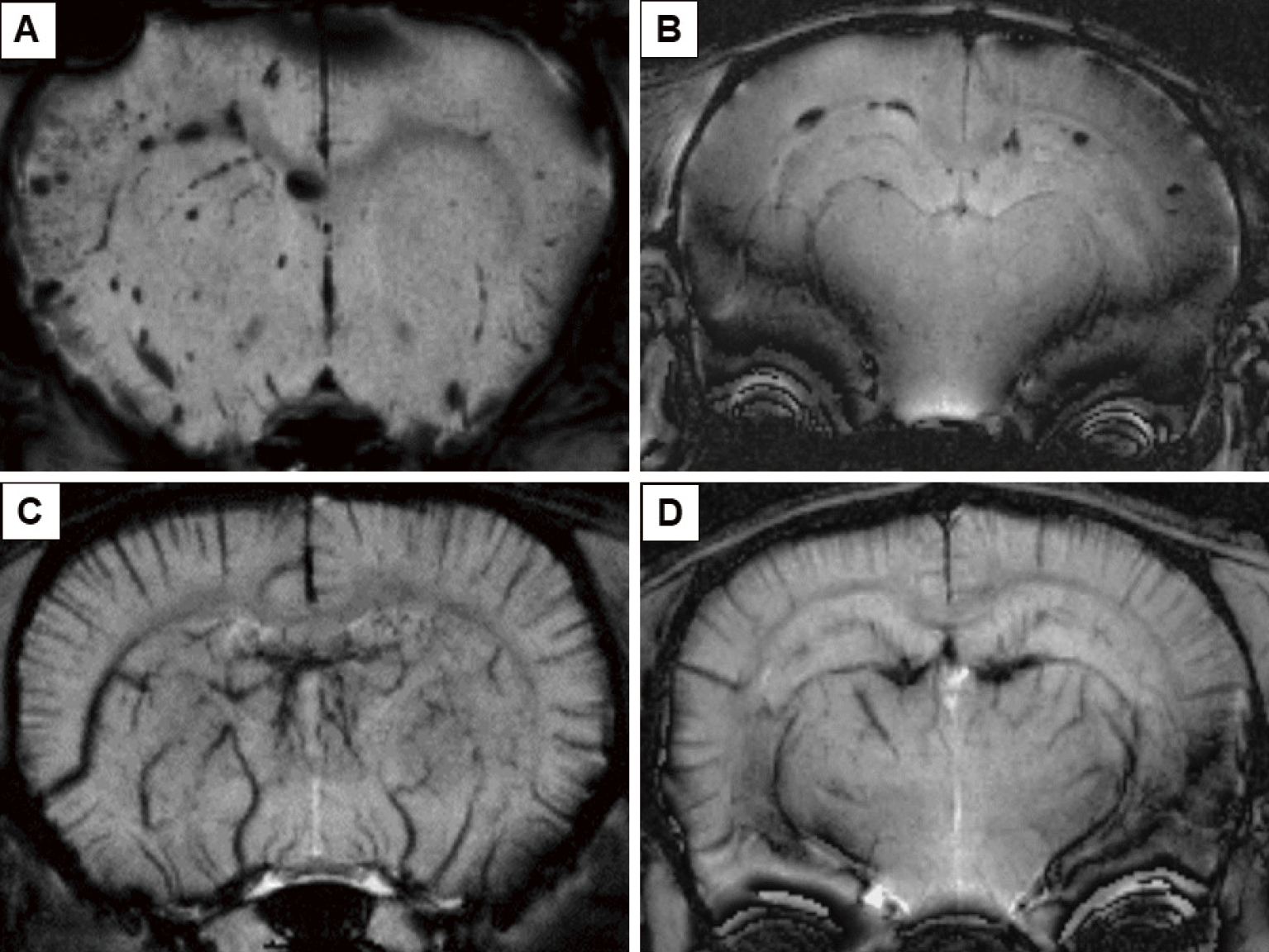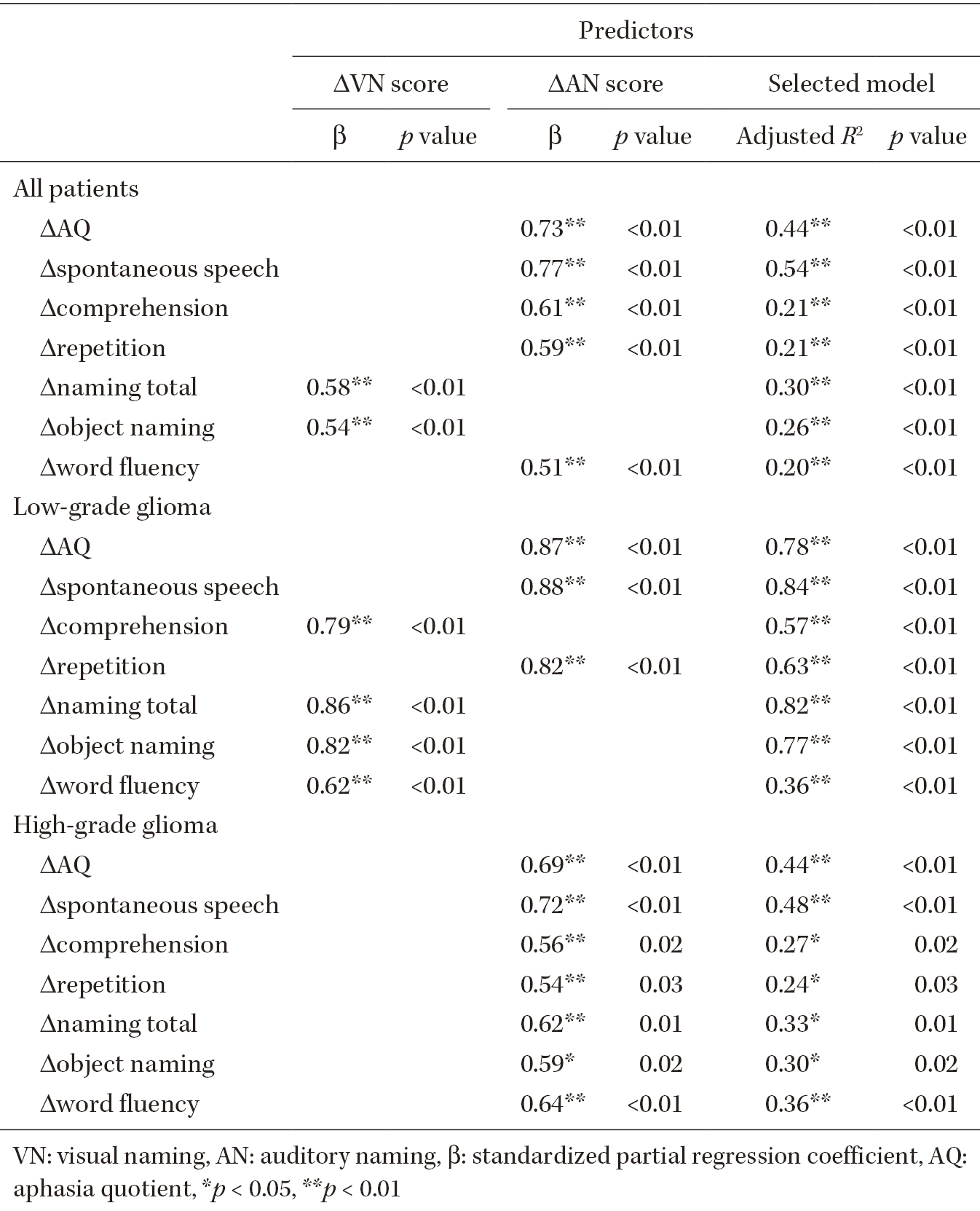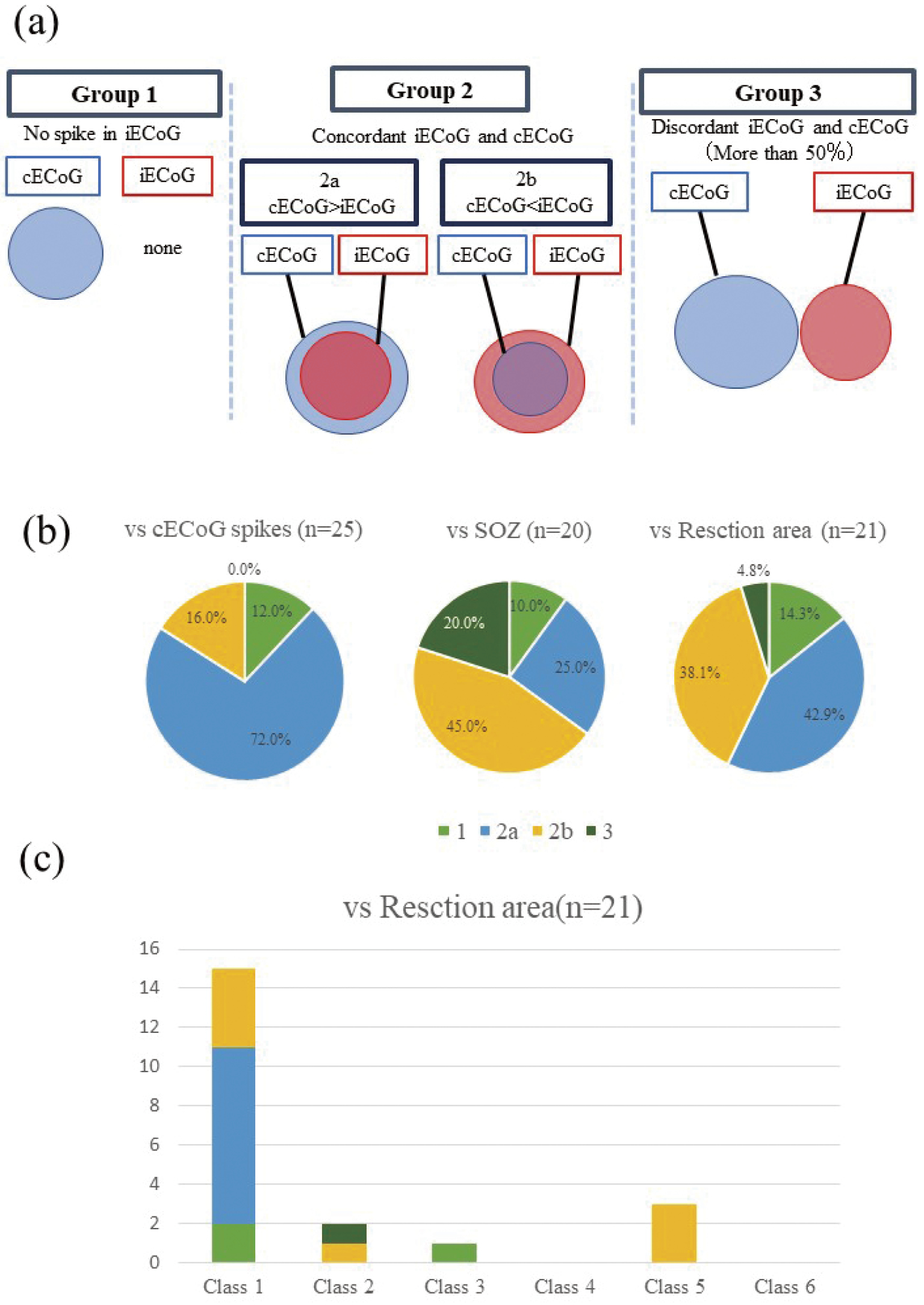- 著者
- Ayaka SASAGAWA Takeshi MIKAMI Yusuke KIMURA Yukinori AKIYAMA Shintaro SUGITA Tadashi HASEGAWA Masahiko WANIBUCHI Nobuhiro MIKUNI
- 出版者
- The Japan Neurosurgical Society
- 雑誌
- Neurologia medico-chirurgica (ISSN:04708105)
- 巻号頁・発行日
- pp.oa.2020-0309, (Released:2020-12-29)
- 参考文献数
- 23
- 被引用文献数
- 2
Gliomas are sometimes difficult to differentiate from strokes and are often misdiagnosed on magnetic resonance imaging (MRI); thus, the terms “stroke mimics” and “stroke chameleons” have been introduced. In this study, we analyzed stroke mimics and stroke chameleons in glioma and discussed the diagnostic perplexity.We retrospectively reviewed cases that were removed from lesions that were considered to be brain tumors. This study enrolled 214 patients who underwent tumor resection for suspected glioma. Clinical characteristics and radiological findings of the patients were compared between the masquerade findings group, which was further divided into two groups: the stroke chameleons and stroke mimics according to their final diagnosis, and the intelligible findings group.Stroke chameleons and stroke mimics were significantly higher in age and smaller in lesion size than the intelligible findings group. In the multivariate analysis, the predictive factor of the masquerade finding group was higher age and smaller size. Stroke mimics group has a tendency to be higher rate of hyperintensity lesion on diffusion-weighted imaging (DWI) compared with stroke chameleons group. The average period from initial diagnosis to pathological diagnosis was 13.50 days in the stroke chameleons and 61.50 days in the stroke mimics, which proved significantly different.Proper diagnosis of glioma and stroke affects a patient’s prognosis, and should be diagnosed as soon as possible. However, stroke mimics and stroke chameleons caused by glioma can occur. Thus, the diagnosis of a stroke should take into consideration the possibility of a glioma in real clinical situations.
3 0 0 0 OA Microbleeds Due to Reperfusion Enhance Early Seizures after Carotid Ligation in a Rat Ischemic Model
- 著者
- Takuro SAITO Takeshi MIKAMI Tsukasa HIRANO Hiroshi NAGAHAMA Rei ENATSU Katsuya KOMATSU Satoshi OKAWA Yukinori AKIYAMA Nobuhiro MIKUNI
- 出版者
- The Japan Neurosurgical Society
- 雑誌
- Neurologia medico-chirurgica (ISSN:04708105)
- 巻号頁・発行日
- pp.2022-0372, (Released:2023-04-06)
- 参考文献数
- 35
Impaired reperfusion in ischemic brain disease is a condition that we are increasingly confronted with owing to recent advances in reperfusion therapy. In the present study, rat models of reperfusion were investigated to determine the causes of acute seizures using magnetic resonance imaging (MRI) and histopathological specimens. Rat models of bilateral common carotid artery ligation followed by reperfusion and complete occlusion were created. We compared the incidence of seizures, mortality within 24 h, MRI, and magnetic resonance spectroscopy (MRS) to evaluate ischemic or hemorrhagic changes and metabolites in the brain parenchyma. In addition, the histopathological specimens were compared with those observed on MRI. In multivariate analysis, the predictive factors of mortality were seizure (odds ratios (OR), 106.572), reperfusion or occlusion (OR, 0.056), and the apparent diffusion coefficient value of the striatum (OR, 0.396). The predictive factors of a convulsive seizure were reperfusion or occlusion (OR, 0.007) and the number of round-shaped hyposignals (RHS) on susceptibility-weighted imaging (SWI) (OR, 2.072). The incidence of convulsive seizures was significantly correlated with the number of RHS in the reperfusion model. RHS on SWI was confirmed pathologically as microbleeds in the extravasation of the brain parenchyma and was distributed around the hippocampus and cingulum bundle. MRS analysis showed that the N-acetyl aspartate level was significantly lower in the reperfusion group than in the occlusion group. In the reperfusion model, RHS on SWI was a risk factor for convulsive seizures. The location of the RHS also influenced the incidence of convulsive seizures.
- 著者
- Soichi OYA Fusao IKAWA Nao ICHIHARA Masahiko WANIBUCHI Yukinori AKIYAMA Hirofumi NAKATOMI Nobuhiro MIKUNI Yoshitaka NARITA
- 出版者
- The Japan Neurosurgical Society
- 雑誌
- Neurologia medico-chirurgica (ISSN:04708105)
- 巻号頁・発行日
- vol.61, no.2, pp.98-106, 2021 (Released:2021-02-15)
- 参考文献数
- 29
- 被引用文献数
- 2 10
Although surgical resection is the most preferred treatment for intracranial meningiomas, a detailed analysis of the surgery-related risks based on large population data has not been conducted to date. In this study, we analyzed the nation-wide brain tumor registry to assess the surgical risk factors for intracranial meningiomas to provide information for an optimal treatment strategy. Data of 4081 meningioma patients who underwent initial resection between 2001 and 2008 were extracted from the Brain Tumor Registry of Japan (BTRJ) database and reviewed for postoperative mortality, aggravation of Karnofsky Performance Score (KPS), and complications. The total in-hospital mortality rate was 0.59%. Male sex and tumor size ≥30 mm were independent risk factors for mortality. Among 4081 cases, 4.4% of patients had KPS that were lowered by 20 or more points at the time of discharge after surgery. Age ≥65 years, higher WHO grading, tumor location at the skull base, tumor size ≥30 mm, and non-gross total resections were associated with lowering of KPS scores by 20 or more points. The overall incidence of surgical complications was 19.3%. The rate of occurrence of new postoperative seizure in patients with supratentorial meningioma was 10.9%. All complications except for vascular complications occurred with significantly lower frequencies in asymptomatic patients than in symptomatic patients. Our results provide useful information regarding the surgical risks when surgical intervention is being considered for intracranial meningiomas. Surgery is an important option for asymptomatic meningiomas as the mortality rate and complication rate in the current study were sufficiently low.
- 著者
- Kazuhiro WAKAMATSU Sumio ISHIAI Nobuko AIHARA Sho KUROKAWA Yusuke KIMURA Nobuhiro MIKUNI
- 出版者
- The Japan Neurosurgical Society
- 雑誌
- Neurologia medico-chirurgica (ISSN:04708105)
- 巻号頁・発行日
- pp.2022-0319, (Released:2023-03-01)
- 参考文献数
- 40
Language tasks for monitoring intraoperative language symptoms have not yet been established. This study aimed to examine whether the quantitative evaluation of language function with visual and auditory naming during awake craniotomy predicts early postoperative language function in patients. Thirty-seven patients with brain tumors in the language-dominant hemisphere were included. They underwent visual and auditory naming preoperatively and at the end of tumor resection for intraoperative evaluation. Using the Western Aphasia Battery, their overall language functions were evaluated preoperatively, early postoperatively (within 1 week), and late postoperatively (after 1 month). The preoperative and intraoperative changes in the visual and auditory naming scores were significantly correlated with most of the Western Aphasia Battery score changes between the preoperative and early postoperative evaluations, which was more remarkable for auditory naming. Multiple linear regression analysis showed that changes in the auditory naming score predicted the preoperative to early postoperative changes in the aphasia quotient of the Western Aphasia Battery. Receiver operating characteristics analysis showed a higher area under the curve or discriminative power for auditory than visual naming in predicting the development or exacerbation of aphasia in the early postoperative period. Considering the analyses applied separately for low- and high-grade glioma, auditory naming, which taps into a wider range of linguistic functions, may be more informative than visual naming as language evaluation in awake craniotomy for the early postoperative development of aphasia, especially for patients with high-grade glioma.
1 0 0 0 OA Usefulness of Intraoperative Electrocorticography for the Localization of Epileptogenic Zones
- 著者
- Ryohei CHIBA Rei ENATSU Aya KANNO Tomoaki TAMADA Takuro SAITO Ryota SATO Nobuhiro MIKUNI
- 出版者
- The Japan Neurosurgical Society
- 雑誌
- Neurologia medico-chirurgica (ISSN:04708105)
- 巻号頁・発行日
- pp.2022-0252, (Released:2022-11-25)
- 参考文献数
- 16
- 被引用文献数
- 1
Intraoperative electrocorticography (iECoG) is widely performed to identify irritative zones in the cortex during brain surgery; however, several limitations (e.g., short recording times and the effects of general anesthesia) reduce its effectiveness. The present study aimed to evaluate the utility of iECoG for localizing epileptogenic zones. We compared the results of iECoG and chronic electrocorticography (cECoG) in 25 patients with refractory epilepsy. Subdural electrodes were implanted with iECoG under general anesthesia (2% sevoflurane). cECoG recordings were performed for 3-14 days. The distribution of iECoG spikes was compared with cECoG spike, seizure onset zone, and resection areas. The concordance patterns of each distribution were classified into four patterns: Group 1: No spike in iECoG, Group 2: concordant (2a: iECoG smaller, 2b: iECoG larger, Group 3: discordant >50%). The concordance rate of interictal spikes, seizure onset zones, and resection areas were 88.0% (Group 2a: 72.0%, Group 2b: 16.0%), 70.0% (Group 2a: 25.0%, Group 2b: 45.0%), and 81.0% (Group 2a: 42.9%, Group 2b: 38.1%), respectively. The resection of iECoG spike areas significantly correlated with good surgical outcomes. The indication and limitations of iECoG need to be realized, and the complementary use of iECoG and cECoG may enhance clinical utility.
- 著者
- Takao YASUHARA Satoshi MURAI Nobuhiro MIKUNI Susumu MIYAMOTO Isao DATE
- 出版者
- The Japan Neurosurgical Society
- 雑誌
- Neurologia medico-chirurgica (ISSN:04708105)
- 巻号頁・発行日
- vol.60, no.7, pp.337-350, 2020 (Released:2020-07-15)
- 参考文献数
- 14
- 被引用文献数
- 4 5
Cranial implants are commonly used throughout the world, yet the data on complications remain partly clarified. The aim of this study was to gather real data in 2018 on complications related to cranial implants in neurosurgery. The survey population consisted of 1103 institutes supplying neurosurgical treatment. The survey consisted of two-stage questionnaire. First the incidence of complications was investigated, then the secondary questionnaire was e-mailed to the respondents about the detailed of the complications. As the result, the annual incidence of complications related to cranial implants was 0.558% in Japan. Titanium plate and mesh were used predominantly in craniotomy and cranioplasty, respectively. The second survey collected data on 449 cases with complications (infection: 63%, implant exposure: 46%, multiple answer). Postoperative infection was associated with male sex, brain tumor, short interval between surgery and complication, usage of ceramics, hydroxyapatite, resin, and artificial dura, hyponutrition, multiple surgeries, dirty wound, and sinusitis as patient factors, and CSF leakage, ruptured sutures, and sinus maltreatment as surgery factors. Meanwhile, long hospital stay was associated with age, male sex, mRS 3–5 before complication, short interval between initial surgery and complication, large craniotomy, long operative time, usage of ceramics and artificial dura, multiple surgeries and dirty wound as patient factors, ruptured suture as a surgical factor, and bacterial infection, especially MRSA infection, as the complication and treatment consisting of removal as complication factors. In conclusion, this is the first Japanese national survey on complications related to cranial implants in neurosurgery. It is important to recall that complications may arise years after surgery and to be aware of the risk factors associated with complications.
- 著者
- Seiichiro IMATAKA Rei ENATSU Tsukasa HIRANO Ayaka SASAGAWA Masayasu ARIHARA Tomoyoshi KURIBARA Satoko OCHI Nobuhiro MIKUNI
- 出版者
- The Japan Neurosurgical Society
- 雑誌
- Neurologia medico-chirurgica (ISSN:04708105)
- 巻号頁・発行日
- vol.62, no.5, pp.215-222, 2022-05-15 (Released:2022-05-15)
- 参考文献数
- 24
- 被引用文献数
- 2
The aim of the present study was to evaluate motor area mapping using functional magnetic resonance imaging (fMRI) compared with electrical cortical stimulation (ECS). Motor mapping with fMRI and ECS were retrospectively compared in seven patients with refractory epilepsy in which the primary motor (M1) areas were identified by fMRI and ECS mapping between 2012 and 2019. A right finger tapping task was used for fMRI motor mapping. Blood oxygen level-dependent activation was detected in the left precentral gyrus (PreCG)/postcentral gyrus (PostCG) along the "hand knob" of the central sulcus in all seven patients. Bilateral supplementary motor areas (SMAs) were also activated (n = 6), and the cerebellar hemisphere showed activation on the right side (n = 3) and bilateral side (n = 4). Furthermore, the premotor area (PM) and posterior parietal cortex (PPC) were also activated on the left side (n = 1) and bilateral sides (n = 2). The M1 and sensory area (S1) detected by ECS included fMRI-activated PreCG/PostCG areas with broader extent. This study showed that fMRI motor mapping was locationally well correlated to the activation of M1/S1 by ECS, but the spatial extent was not concordant. In addition, the involvement of SMA, PM/PPC, and the cerebellum in simple voluntary movement was also suggested. Combination analysis of fMRI and ECS motor mapping contributes to precise localization of M1/S1.


